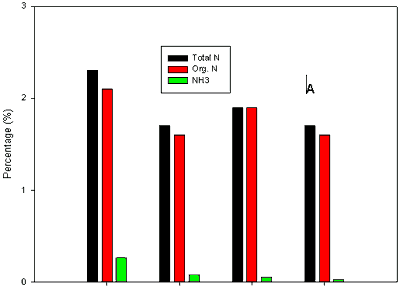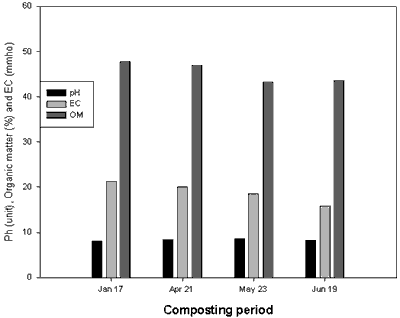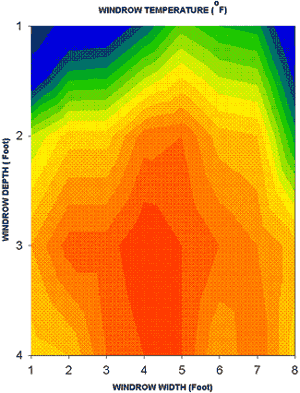Composting Animal Manure
Mohammed
Zerkoune, Agricultural Agent, Yuma County Cooperative Extension
Abstract
Producers in Yuma, Arizona, use about one million tons of manure yearly on crops. Animal manure use is well accepted among growers and the demand for manure is projected to increase as organically grown vegetables and fruits gain in popularity. The application of raw manure on agricultural fields increases the risk of weed infestation and pathogen contamination. Composting manure reduces the risk of weed seed infestation and pathogen contamination. Research work done on composting in a low desert environment is very limited. The objective of this investigation is to evaluate the effect of composting on nutrient analysis, and seed and pathogen destruction. Manure and wheat straw mixture was aerobically composted for five months. Total nitrogen, ammonia and organic nitrogen decreased significantly. Weed seed and bacteria were less than 2%.
Introduction
Total number of cattle in the state of Arizona is estimated at 840,000 head (Arizona Ag Statistics, 2000). On the average, 0.27 pounds of N, 0.093 pounds of P and 0.29 pounds of K are excreted daily by a single animal of 1,000 pounds based on live weight (Overcash et al., 1993a). Assuming all nutrients in
manure produced are collected, the estimated total of 104.9 tons of N, and 35.9 tons of P and 110.5 tons of K are generated daily.
However, manure is often viewed as a waste management problem (DeLuca and DeLuca, 1997) due to the availability of inexpensive man made commercial fertilizer and the prohibitive hauling cost of manure from the confinement to the agricultural fields. This results in manure disposal at excessive rates on agricultural fields nearby the feedlot or disposed on crop fields without consideration to nutrient values (Padgitt, 1984). The manure removal from confined animal feed operation (CAFO) and its disposal on nearby agricultural fields is also due to the lack of storage space, since manure can only be applied between two successive crops.
During the growing period, manure is stored or composted. Composted manure is a potential source of bioavailable nutrients needed for organically grown vegetables in the southwest, free from weed seeds and pathogens. The objective of this research is to evaluate the effects of composting beef cattle feedlot manure mixed with 10% wheat straw on nutrient analysis and seed and pathogen viability.
Materials and Methods
Manure was scraped from a partially paved feedlot near the feed bunks and unpaved areas elsewhere. Manure was hauled by trucks to a 30-acre compost area located on sandy soils (Gilman-Vint-Brios Association) near the feedlot. The compost area was leveled and then compacted to minimize nutrient infiltration. Since the total monthly rainfall rarely exceed 2.5 cm, the effect of run off is considered minimum.
Wheat straw was added to manure to obtain a 10:1 manure straw ratio. The manure and straw mixture was composted in windrows 300 feet long, 15 feet wide and 5 feet high at the center of the windrow and replicated three times. The amount of manure laid in each windrow was 300 tons. The initial moisture content in the manure, when removed from the feedlot, was 20%. Each windrow was watered with a water truck to maintain the moisture content near 40-50%. The watering was performed before turning the compost for dust control. Windrows were watered and turned twice a week for the first month, then once a week thereafter, using a compost turner. Immediately after compost turning and mixing, we collected four samples from each windrow and mixed samples thoroughly to form one composite sample per replication. Samples were sealed in plastic bags and shipped over night for laboratory analysis.
Daily temperature in the compost pile was recorded from zero to four feet in one foot-increment. In addition, a transect temperature data was collected across the windrow at one, two, three and 4 feet depths and one foot increments across the windrow to determine the temperature distribution in the windrow. The experiment was replicated four times. The analysis of variance was performed using general linear model (SAS Ver.7), and mean comparison was made with MRT
Results and discussion
From January to July, daily temperature (not reported) was recorded at four different depths. In addition, transect was taken across the windrow to determine temperature distribution at the center of the windrow (figure 1). There is a formation of "a hot zone" in the center of the windrow where temperature reached 160 oF then decreased outward in all directions. This emphasizes the importance of turning the compost in order to keep even temperatures of the compost as much as possible. Temperature at one foot did not exceed 140 oF. The highest temperature was recorded at 3 feet deep. Near the surface (one foot), recorded temperature was influenced by the seasonal ambient temperature.Data were collected to evaluate the nutrient concentration of wheat straw and manure composted together with a 1 to 10 straw /manure ratio. Samples were collected four times following compost turning and sent for laboratory analysis. Total N, organic N, and Ammonia content decreased significantly over the four-month period due to ammonia volatilization (figure 2). This is in agreement with the results reported by Eghball and Power, (1994). Total N was initially 2.3% and decreased to 1.7%. Organic N decreased from 2.1 to 1.6%. The most drastic ammonia loss was found at the end of the experiment. At the beginning, the ammonia loss was rapid and tended to stabilize toward the end.


Figure 2. The effect of composting beef cattle feedlot manure on:
A) total, organic and ammonia nitrogen change and
B) organic matter (OM), pH, and electical conductivity (EC) change of
feedlot manure
No change in electrical conductivity (EC) and pH was observed. Phosphorus, potassium, and calcium were affected by the duration of composting (data not shown). These results are also in agreement with the published data (Eghball and Power, 1994).
At the end of the experimental period, the number of viable weed seeds and pathogens were less than 2% and 2 MPN (most probable number) per gram of compost. The particle size distribution showed that less than 50% of the total compost is less than 5 cm in diameter. A finer particle size of the compost would have been observed had the wheat straw been chopped.
Conclusion
Nutrients from manure are valuable resources for agricultural crops. Research data available elsewhere cannot be extrapolated to the desert environment. Currently, there is very little research data available in Arizona that evaluates nutrient management from manure. This investigation was conducted to evaluate the effect of composting beef cattle feedlot manure mixed with wheat straw in desert environment on nutrient analysis.
Temperature recorded during the investigation has reached the level needed for weed seed and pathogen destruction. Temperature at the center of windrows reached 160 oF then decreased with distance from the center. This shows the importance of turning the compost pile regularly.
Results showed that both chemical and physical properties of the composted material were affected by the duration of composting.
Total nitrogen, organic nitrogen, and ammonia and organic matter were significantly affected by composting. Ten percent of wheat straw added to manure did not significantly affect the final result of compost. At the end of the composting period, less than 2% of weed seed remained viable and pathogen destruction was evaluated at less 2 MPN/ gr. Further investigation is needed to evaluate the effect of composted manure on crop yield and quality.
References
Eghball, B., J. Power. 1994. Beef cattle feedlot manure management. J. Soil and water conservation. 49:113-122
Padgitt, S. 1984. Farming operations and practices in Big Spring Bassin. Iowa State Univ. Coop. Ext. Serv. CRD 229.
Overcash, M.R., F.R. Huminik , and J.R. miner. 1983. Livestock waste management Vol. 1CRC Press. Boca Raton Fl.
Deluca, T.H., D.K. Deluca. 1997. J. Composting for feedlot manure management and soil quality. Proc.Agric. Am.Soc. Agron. Madison Wis.
Acknowledgment
The author expresses thanks to Larry Mc Donald and Oscar Robles of McElhaney Cattle Company for their cooperation and support during this research work.
Issued in furtherance of Cooperative Extension work, acts of May 8 and June 30, 1914, in cooperation with the U.S. Department of Agriculture, James A. Christenson, Director Cooperative Extension, College of Agriculture and Life Sciences, The University of Arizona.
The University of Arizona is an equal opportunity, affirmative action institution. The University does not discriminate on the basis of race, color, religion, sex, national origin, age, disability, veteran status, or sexual orientation in its programs and activities.
Any products, services, or organizations that are
mentioned, shown, or indirectly implied in this web document do not imply
endorsement by The University of Arizona.
Information provided by:
Mohammed Zerkoune, zerkoune@ag.arizona.edu Extension Agent, Agriculture
University of Arizona, Tucson, Arizona.
Material written January 2001.
For more Arizona Production Ag Information:
Home | Cotton | Veggies| Forages | Grains | Citrus | Crop x Crop | Insects | Diseases| Weeds | Pesticides | News | Weather | Research | Photos | Contacts | General Info. | Site Map
document located at: http://cals.arizona.edu/crops/counties/yuma/farmnotes/fn0401compost.html
Copyright © 2001 University of Arizona,
College of Agriculture and Life Sciences
Webmaster: Al Fournier (fournier@ag.arizona.edu)
